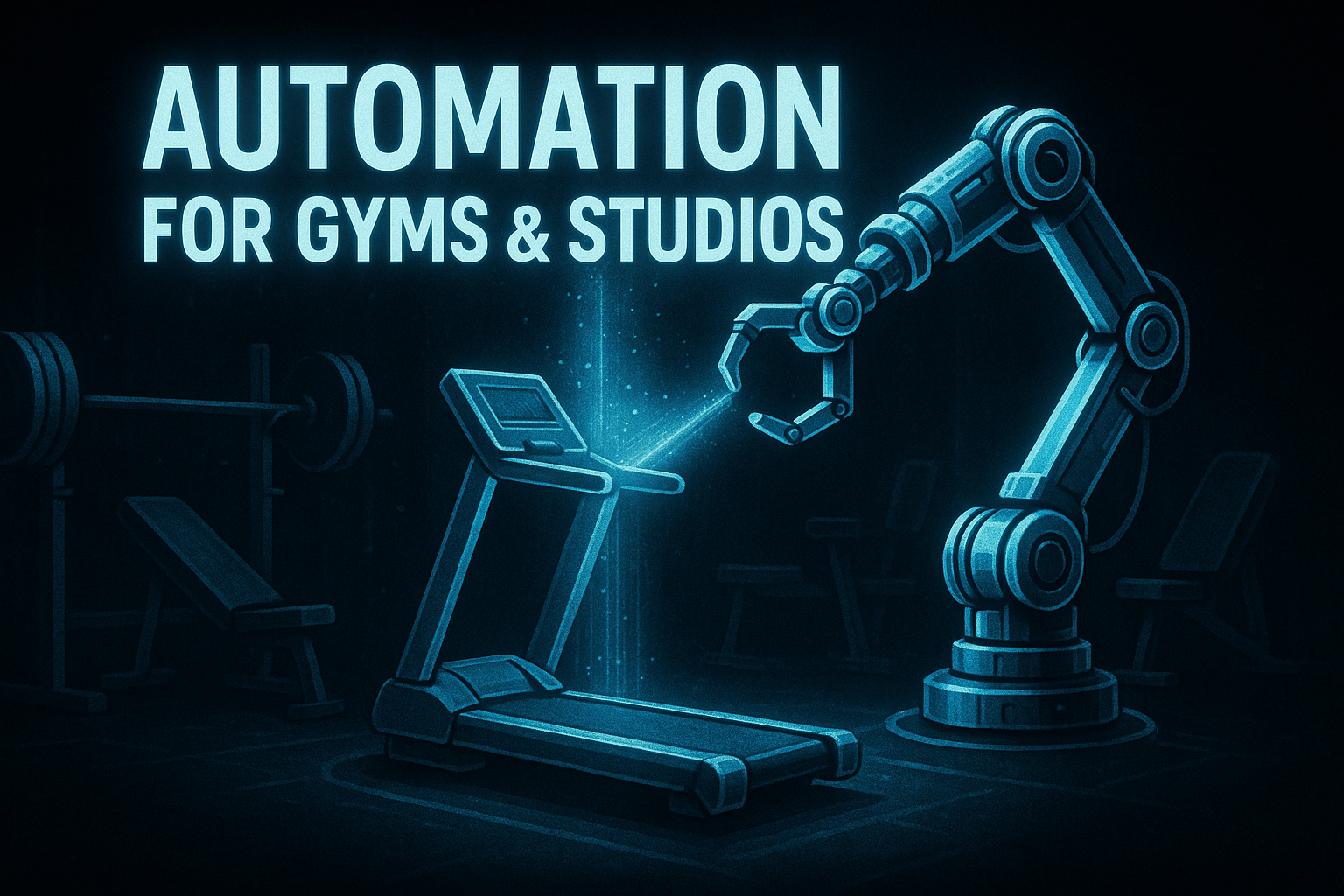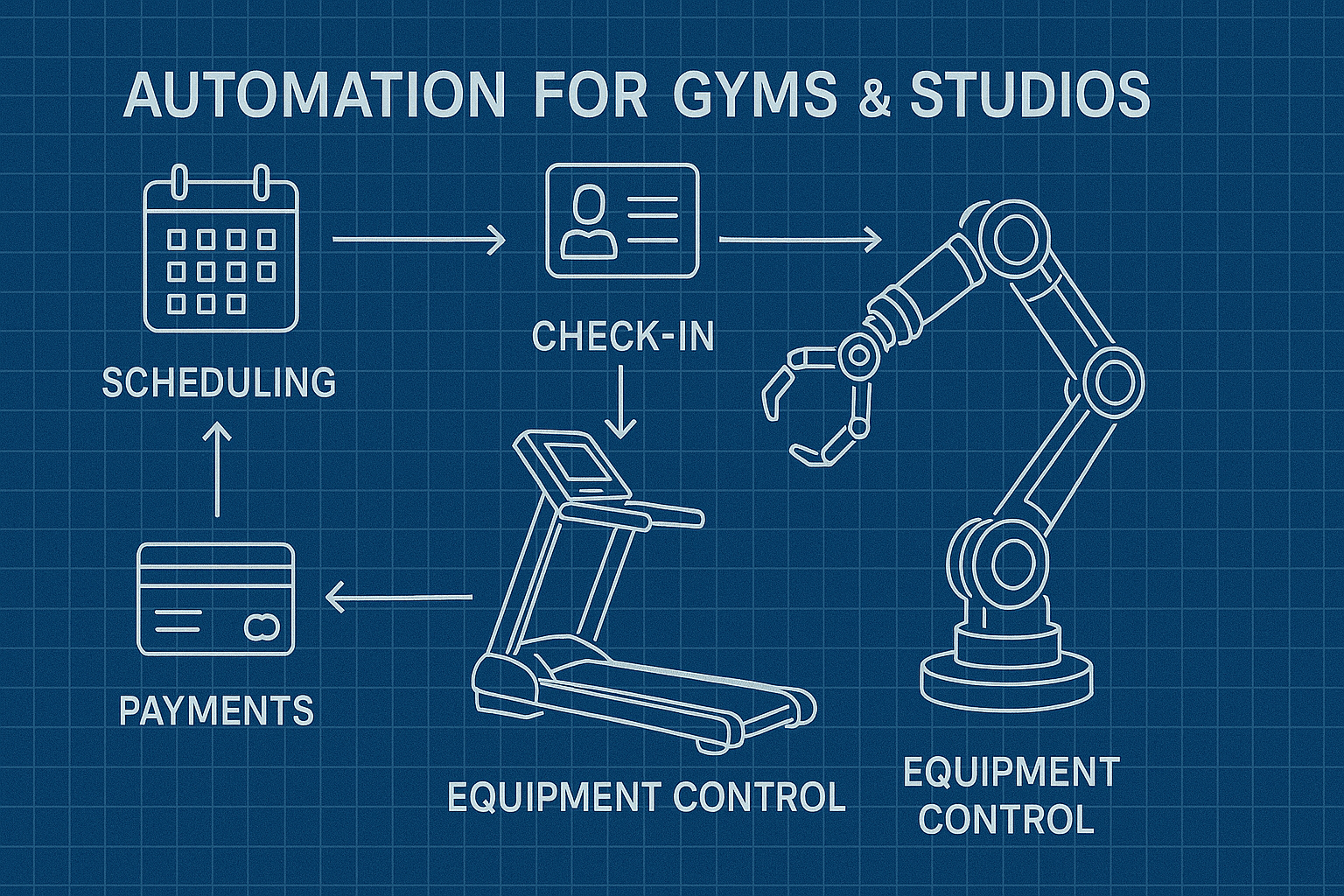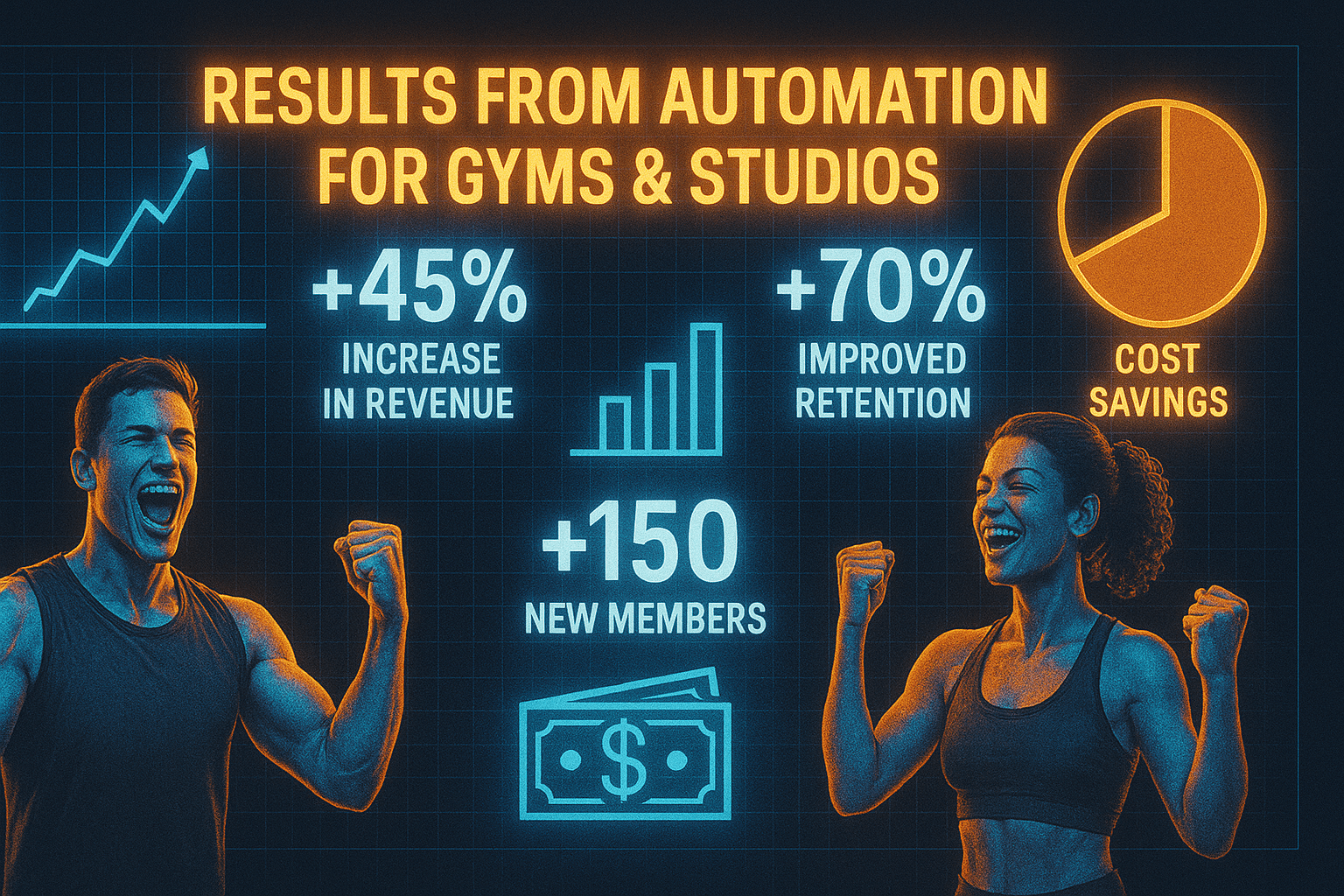How Smart Automation Transforms Gyms & Studios: A Complete Implementation Guide
by Design Delulu Editorial · October 18, 2025

Smart, fast, and measurable. Here's how Automation helps Gyms & Studios win.
The fitness industry is evolving at breakneck speed, and gyms and studios that rely on manual processes are falling behind. While you're managing spreadsheets, answering the same questions repeatedly, and manually tracking member attendance, your competitors are leveraging automation to deliver seamless experiences that keep members engaged and revenue growing. The difference isn't just operational efficiency—it's about creating a scalable foundation that allows your business to thrive without burning out your team.
Automation for gyms and studios isn't about replacing the human touch that makes your business special. It's about eliminating repetitive tasks so your staff can focus on what truly matters: building relationships, delivering exceptional classes, and creating transformative fitness experiences. From automated booking confirmations and payment processing to intelligent member engagement sequences and data-driven decision making, the right automation system becomes your competitive advantage in an increasingly crowded market.

Why Gyms & Studios Need Automation Now
The traditional gym and studio model is breaking under its own operational weight. Front desk staff spend countless hours on administrative tasks that could be automated. Instructors juggle teaching with manual attendance tracking. Owners drown in data from disconnected systems, unable to extract actionable insights. This operational chaos creates three critical problems:
Member experience suffers when systems don't talk to each other. A new member signs up online but receives contradictory information via email. Class schedules change but notifications fail to reach everyone. Payment issues arise but no automated system flags them until the member shows up confused. These friction points compound, turning excited new members into churned statistics.
Revenue leaks through manual processes. Failed payments go unnoticed for weeks. Membership renewals require manual follow-up. Upsell opportunities disappear because no system identifies members ready for personal training packages. The average gym loses 15-20% of potential revenue simply through operational inefficiency.
Growth becomes impossible without automation. Opening a second location means duplicating all manual processes. Scaling your team requires extensive training on disconnected systems. Expanding class offerings creates scheduling nightmares. Without automation, growth means proportionally more chaos.
Modern gym and studio automation solves these challenges by creating an integrated ecosystem where member data flows seamlessly, operations run on autopilot, and your team focuses on high-value activities that actually grow your business.
The Complete Automation Framework for Fitness Businesses
Successful automation for gyms and studios requires a strategic, layered approach that addresses every touchpoint in the member journey while providing operational intelligence for business decisions. Here's the comprehensive framework that transforms fitness businesses:
Member Acquisition & Onboarding Automation
The journey from prospect to active member involves dozens of interactions that can be streamlined without losing personalization. Lead capture automation ensures every website visitor, social media inquiry, and walk-in prospect enters your system immediately with appropriate follow-up triggers. Automated lead scoring identifies high-intent prospects based on behavior patterns, allowing your team to prioritize conversations that convert.
Onboarding sequences transform the critical first 30 days. New members receive timed welcome messages, facility orientation reminders, class recommendations based on stated goals, and equipment tutorials. Automated check-ins at days 7, 14, and 21 catch friction points before they cause churn. Integration with your booking system automatically suggests complementary classes based on attendance patterns.
Key automation elements include:
- Instant lead response systems that engage prospects within 5 minutes of inquiry
- Personalized welcome sequences tailored to membership type and stated fitness goals
- Automated goal-setting workflows that capture member objectives and track progress
- Equipment orientation scheduling that integrates with staff calendars automatically
- First-class booking prompts sent at optimal times based on member availability patterns
Operations & Scheduling Automation
Daily operations consume massive staff hours that automation reclaims. Class and appointment scheduling becomes intelligent, with systems that manage capacity, waitlists, and instructor availability without human intervention. Members book, reschedule, and cancel through self-service portals while your system maintains optimal class sizes and prevents revenue-killing gaps.
Attendance tracking automation eliminates check-in bottlenecks and provides real-time occupancy data. Integrated with your CRM, attendance patterns trigger engagement campaigns for members showing decreased activity. No-show patterns activate retention workflows before members ghost entirely.
Staff scheduling and management becomes predictive rather than reactive. Systems analyze historical attendance data, seasonal patterns, and member preferences to suggest optimal instructor schedules. Time-off requests automatically trigger substitute instructor notifications. Payroll integration eliminates manual timesheet management.
Operational automation includes:
- Dynamic class capacity management that adjusts based on instructor, room size, and equipment availability
- Automated waitlist processing with instant member notifications when spots open
- Equipment maintenance tracking with usage-based service reminders
- Inventory management for retail with low-stock automatic reordering
- Facility access control integration for 24/7 unmanned hours

Revenue & Payment Automation
Revenue automation ensures consistent cash flow while reducing administrative burden. Automated billing and payment processing handles recurring memberships, class packages, and retail transactions with intelligent retry logic for failed payments. Members receive automated payment confirmations, upcoming charge notifications, and year-end tax summaries.
Failed payment recovery sequences automatically attempt card processing at optimal times, send payment update reminders, and pause membership access when necessary—all while maintaining a professional, relationship-focused tone. This automation typically recovers 60-70% of failed payments that would otherwise require manual collection efforts.
Upsell and cross-sell automation identifies revenue opportunities based on member behavior. Members consistently attending group classes receive automated personal training offers. Long-term members get loyalty rewards automatically applied. Retail recommendations appear based on class attendance patterns and stated goals.
Financial automation components:
- Intelligent payment retry logic that optimizes timing and method
- Automated invoice generation and delivery for corporate wellness contracts
- Dynamic pricing adjustments for peak vs. off-peak class times
- Package expiration notifications with renewal prompts at optimal times
- Referral reward tracking and distribution without manual intervention
Member Engagement & Retention Automation
Retention drives profitability in the fitness industry, and automation makes proactive engagement scalable. Behavioral trigger campaigns respond to member actions automatically: completing milestone workouts triggers celebration messages, decreased attendance activates re-engagement sequences, and achievement of stated goals prompts next-level challenges.
Personalized communication streams keep members connected without overwhelming your team. Birthday messages, membership anniversaries, workout streaks, and personal records get recognized automatically. Content recommendations based on interests and goals arrive at times when members are most likely to engage.
Churn prediction and prevention uses machine learning to identify at-risk members before they cancel. Automated interventions offer class swaps, schedule adjustments, or check-in calls from staff—all triggered by behavioral patterns that indicate disengagement.
Engagement automation tactics:
- Achievement celebration sequences that recognize milestones automatically
- Inactivity alerts that trigger progressively personalized re-engagement attempts
- Community building automation that connects members with similar goals
- Challenge and competition systems that run without manual management
- Feedback collection and response workflows that close the loop on member experience
Data Intelligence & Analytics Automation
The true power of automation emerges when systems don't just execute tasks but generate actionable intelligence. Modern gym and studio automation creates a data foundation that drives strategic decisions and continuous improvement.
Event & Ecommerce Tracking Architecture
Comprehensive event tracking captures every meaningful member interaction across all touchpoints. Class bookings, cancellations, website visits, email opens, app usage, facility check-ins, and purchase behaviors flow into a unified data warehouse. This creates a complete picture of the member journey from first touchpoint to long-term loyalty.
GA4 and server-side tagging implementation ensures data accuracy while maintaining member privacy. Server-side tracking eliminates issues with ad blockers and browser restrictions that corrupt client-side analytics. Cookie-less tracking methodologies future-proof your data infrastructure against evolving privacy regulations.
Ecommerce tracking integration connects online and offline revenue streams. Retail purchases, membership upgrades, personal training packages, and class pack sales all feed into attribution models that reveal which marketing channels drive actual revenue, not just leads.
Dashboard & Reporting Automation
Source-of-truth dashboards in Looker Studio eliminate manual report creation and data discrepancies. Real-time visualizations show member acquisition costs, lifetime value trends, class utilization rates, revenue per square foot, instructor performance metrics, and retention cohort analysis. Automated anomaly detection alerts you to issues before they compound.
Custom reporting for different stakeholders ensures everyone gets relevant insights automatically. Instructors see class attendance trends and member feedback summaries. Front desk staff access daily operational metrics. Owners receive executive dashboards with financial performance and strategic KPIs. Reports generate and distribute on automated schedules without manual intervention.
Predictive analytics dashboards move beyond historical reporting to forecasting. Machine learning models predict membership churn risk, optimal class schedules based on demand patterns, and revenue projections under different growth scenarios. This transforms reactive management into proactive strategy.
Attribution Modeling for Fitness Businesses
Multi-touch attribution reveals which marketing activities actually drive memberships. Traditional last-click attribution might credit a Google search, but multi-touch models show the social media post, email nurture sequence, and facility tour that collectively converted the prospect. This intelligence optimizes marketing spend and reveals unexpected high-performers.
Funnel-specific attribution models account for the unique fitness buyer journey. Awareness activities (social media, content marketing) receive appropriate credit alongside conversion activities (trial offers, facility tours). Models weight touchpoints based on their stage-appropriate influence rather than generic algorithms.
Offline-to-online attribution connects digital marketing to in-person conversions. Walk-in prospects who found you through Instagram get properly attributed. Members who heard about you from friends but searched online before joining get appropriate referral and digital credit. This complete view prevents undervaluing high-performing channels.

Implementation Strategy: From Planning to Performance
Successful automation implementation follows a strategic process that minimizes disruption while maximizing impact. Here's the proven methodology that transforms gym and studio operations:
Phase 1: Discovery & Strategic Alignment
Before implementing any automation, we establish clear outcomes and constraints. Business objective mapping connects automation initiatives to specific revenue, retention, or operational efficiency goals. This ensures every automated workflow drives measurable business value rather than just technical impressiveness.
Current state assessment documents existing processes, pain points, and system limitations. We identify quick-win automation opportunities alongside strategic transformations that require more extensive implementation. This creates a prioritized roadmap that delivers early value while building toward comprehensive automation.
Success metrics definition establishes how we'll measure automation impact. Metrics might include member retention rate, staff hours saved, revenue recovery from failed payments, lead-to-member conversion rate, or class utilization improvement. Clear KPIs enable data-driven optimization throughout implementation.
Phase 2: Architecture & Blueprint Design
System integration architecture designs how your existing tools connect and share data. Most gyms use multiple platforms: membership management software, booking systems, payment processors, email platforms, and potentially separate CRM tools. The blueprint creates seamless data flow between these systems without forcing wholesale platform replacement.
Workflow documentation maps every automated process in detail. Trigger conditions, decision logic, messaging content, timing specifications, and exception handling all get documented before implementation begins. This prevents scope creep and ensures automation behaves predictably.
Measurement plan creation defines exactly what data gets tracked, where it's stored, and how it's analyzed. Event taxonomies ensure consistent naming conventions. Data warehouse schemas organize information for efficient querying. Dashboard specifications outline what metrics appear for which stakeholders.
Phase 3: Build, Test & Launch
Staged implementation rolls out automation incrementally rather than attempting massive simultaneous changes. Initial phases might automate email communications and payment retry logic. Subsequent phases add scheduling optimization and predictive analytics. This approach allows your team to adapt and provides opportunities to refine before expanding scope.
Comprehensive QA testing validates automation behavior before member-facing deployment. Test scenarios cover normal operations, edge cases, and failure modes. Data accuracy verification ensures analytics capture information correctly. User acceptance testing involves staff who'll interact with automated systems daily.
Change management and training prepares your team for new workflows. Documentation explains how automation changes daily processes. Training sessions ensure staff understand when to let automation handle tasks versus when to intervene manually. Ongoing support addresses questions as the team adapts.
Phase 4: Optimization & Continuous Improvement
Performance monitoring tracks automation effectiveness against established KPIs. Weekly reviews identify workflows performing below expectations. Monthly analyses reveal optimization opportunities. Quarterly strategic reviews assess whether automation priorities should shift based on business evolution.
A/B testing automated workflows continuously improves performance. Email subject lines, message timing, upsell offers, and re-engagement sequences get systematically tested. Winning variants become new standards while losing variants get replaced. This ensures automation improves over time rather than becoming stale.
Expansion planning identifies new automation opportunities as your business grows. Opening new locations becomes easier with proven automation playbooks. New service offerings get automation support from launch. Staff additions require minimal training because systems handle complexity.
Deliverables & Tangible Outcomes
Professional gym and studio automation implementation produces specific, actionable deliverables that become operational assets:
Comprehensive tracking plan documentation serves as your ongoing reference for what data gets collected, how it's structured, and what it means. This living document evolves as your business adds new services or marketing channels, ensuring data consistency even as operations scale.
GA4 and server-side tag implementation provides enterprise-grade analytics infrastructure that captures accurate data while respecting member privacy. Complete configuration includes custom events for fitness-specific actions, conversion tracking for all revenue streams, and audience definitions for remarketing and analysis.
Custom dashboards and reporting infrastructure delivers real-time operational intelligence and strategic insights. Dashboards refresh automatically, eliminating manual report creation. Automated distribution ensures stakeholders receive relevant information on schedules that support decision-making rhythms.
Attribution model configuration reveals marketing ROI with unprecedented accuracy. Properly configured attribution connects marketing spend to member acquisition and lifetime value, enabling data-driven budget allocation that maximizes growth efficiency.
Process documentation and runbooks ensure your team can maintain and evolve automation systems. Standard operating procedures cover routine management tasks, troubleshooting common issues, and requesting enhancements as business needs evolve.
Best Practices for Sustainable Automation Success
Maximizing automation value requires ongoing attention to strategy, not just initial implementation. These practices separate high-performing fitness businesses from those whose automation languishes:
Prioritize high-impact workflows first. Not all automation delivers equal value. Focus initial efforts on workflows that directly impact revenue (payment processing, upsells) or member experience (onboarding, engagement). Lower-value administrative automations can wait until core systems prove their worth.
Pair every automation with measurement. If you can't measure whether an automated workflow performs better than manual processes, you can't optimize it. Define success metrics before implementation, track them consistently, and use data to guide refinement. Automation without measurement is just blind hope.
Maintain human oversight for critical touchpoints. Automation should handle routine tasks and flag exceptions for human attention, not attempt to replace judgment entirely. Failed payment recovery might automate initial retries, but persistent issues should escalate to staff who can have relationship-preserving conversations.
Use templates and frameworks to scale efficiently. Document successful automation patterns so you can replicate them across locations, class types, or membership tiers. Email sequence templates, dashboard configurations, and workflow designs become reusable assets that accelerate expansion.
Schedule regular review and refinement cycles. Weekly operational reviews catch immediate issues. Monthly performance analyses identify optimization opportunities. Quarterly strategic reviews assess whether automation priorities align with evolving business objectives. This cadence prevents automation decay.
Build data governance into operations from day one. Establish naming conventions, documentation standards, and quality checks that prevent the data chaos automation aims to eliminate. Clean, consistent data enables reliable automation and trustworthy analytics. Garbage in, garbage out applies to automation even more than manual processes.
Industry-Specific Automation Strategies for Gyms & Studios
Fitness businesses have unique characteristics that require tailored automation approaches beyond generic marketing or CRM systems:
Map search intent to buyer journey stages. Prospects searching for "yoga classes near me" are further along the journey than those researching "benefits of yoga." Automation should capture both but route them to appropriate nurture sequences. Early-stage prospects need educational content and social proof. Late-stage prospects need facility tours and trial offers.
Leverage social proof throughout the member lifecycle. New member success stories resonate differently than long-term transformation testimonials. Automate delivery of stage-appropriate social proof: trial class participants see "first week" stories, while long-term members receive "year-long journey" content. This increases relevance and conversion at every stage.
Implement single-source-of-truth dashboards ruthlessly. Fitness businesses often have data scattered across booking systems, payment processors, door access logs, and CRM platforms. Conflicting reports create confusion and poor decisions. Invest in comprehensive data integration so everyone references identical metrics from one authoritative dashboard.
Embrace rapid iteration over perfect launches. The fitness industry moves quickly—class trends shift, member preferences evolve, and competitive dynamics change constantly. Launch automation quickly, gather data, refine based on results, and compound improvements. Perfect automation that launches slowly loses to good automation that improves continuously.
Automate community building at scale. Fitness businesses thrive on community, but community building doesn't scale manually. Automate member introductions based on shared goals or attendance patterns. Create automated challenge systems that foster friendly competition. Use behavioral triggers to recognize achievements publicly in member communities.
Balance automation with authentic human connection. Members join fitness businesses for results but stay for relationships. Automation should create more opportunities for meaningful human interaction, not replace it. Use automation to handle administrative tasks so instructors can focus on coaching, motivation, and personal connection.
Frequently Asked Questions
Let’s level up your Gyms & Studios business
Need services that actually move the needle for Gyms & Studios? See our approach, pricing, and timelines—then book a quick call.
Additional Resources
- Schedule a Strategy Call
Book a complimentary 30-minute consultation to discuss your gym or studio's specific automation needs. We'll assess your current systems, identify quick-win opportunities, and outline a customized implementation roadmap with transparent pricing.
- View Our Portfolio
Explore real-world automation implementations for gyms and studios. See detailed case studies showing measurable improvements in member retention, revenue growth, and operational efficiency across diverse fitness business models.
- Free Automation Tools
Access our collection of free resources including automation readiness assessments, ROI calculators, workflow templates, and planning worksheets designed specifically for fitness business owners evaluating automation investments.
Related Reading

Discover how automation for electricians streamlines scheduling, invoicing, lead tracking, and customer follow-ups to boost revenue and efficiency. Get started today.

Discover how automation streamlines furniture & home decor operations with GA4 tracking, attribution modeling, and data-driven dashboards. Get your 90-day implementation roadmap.
